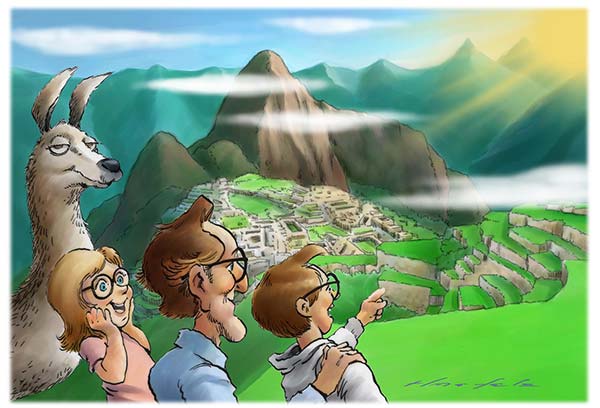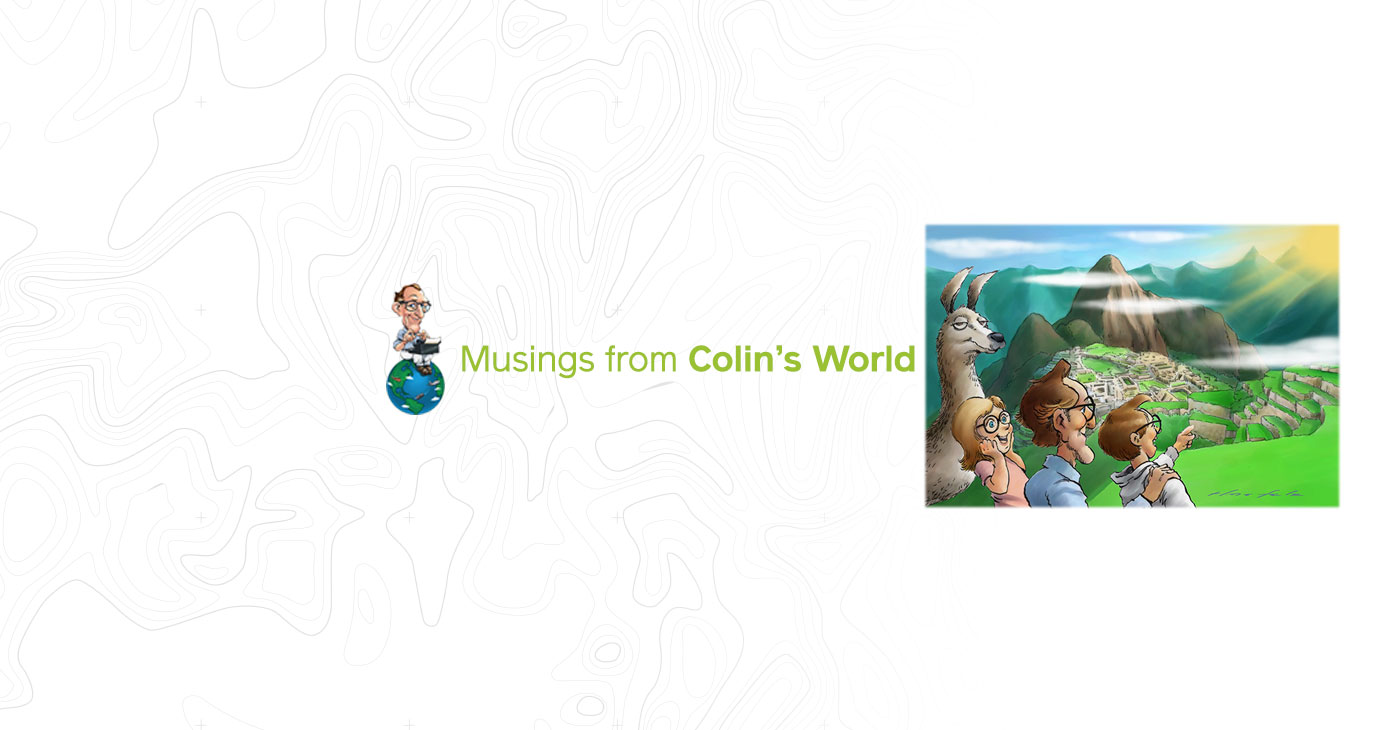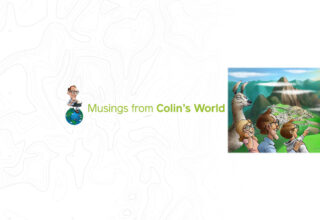I’m not big on ratings. I feel no need to choose which is best among New York, Paris, London and Rome. What’s the point? At a certain level of fabulousness such comparisons are demeaning. Anyway, those kinds of preferences are personal, and specific to time and place. When I am in Vienna, it’s the center of the universe – and perish the thought of anyone even suggesting any competitors. Then again, when in Rome…
But when someone mentions Machu Picchu, I can barely restrain myself from blurting out that Machu Picchu is probably the most magical place I have ever been. My obsession with Machu Picchu was ignited the moment I laid eyes on that iconic image, looking down upon the ruins of buildings on a mountaintop, with a dark, mysterious peak looming over it. That photo itself was enough to cement it into my mind as a place I had to go.
And there was that enchanting name: Machu Picchu. What magical-sounding words! And to clinch it, the backstory of an abandoned ancient city high on a mountaintop that was discovered for the world in 1911 by a Yale University history lecturer named Hiram Bingham, who was actually looking for two other lost cities of the Incan civilization. And very little is known for certain about its origins. That was it. I was hooked.
The Iconic View
Almost all the pictures of Machu Picchu are variations of a single view, that astonishing view that captured me, and millions of others. The image is so riveting that no one presenting Machu Picchu can resist using it. The peak shown in the photos is actually Huayna Picchu, which means “young mountain.” The photos are taken from above, at a point on Machu Picchu (“old mountain”), a broad ridge of a mountain. The city was built on a lower extension of the larger mountain.
As gripping as that image is, it only shows a small part of the city. What impressed me most when I went there was the sheer magnitude of the site. The vast, labyrinthian sprawl spreads over five miles, with more than 150 buildings. It has a huge, expertly crafted system of terraces along its steep mountainsides, with more than 3,000 stone steps connecting them.

But, as amazing as the city is, it is completely upstaged by the natural beauty of the place. It is one of the most stunning places I have ever seen. The mountain on which you stand is surrounded by innumerable other peaks of the Andes range, in rows cascading off into the distance, to where snow-capped peaks meet the horizon.
Part of why it was not previously discovered is its physical inaccessibility. It’s at the top of sharply steep mountains, rising more than 1,000 feet from the valley floor. What a perfect place to build a city! I could see it as so beautiful, and constantly changing with the cycles of the solar system and the weather, that one might be content to stay there forever.
Vast Mystery
What is known for certain about Machu Picchu is miniscule compared to what is not known. Speculation runs in many directions. The currently accepted truth is really only a gesture toward a range of possibilities. One theory supplants another. But they are all speculation, with wide margins of error. That’s fun and fascinating because it leaves plenty of room for the imagination to wander around in all the possibilities, and consider various alternate versions of the history of that magical place.
Bingham, the discoverer, mislabeled it in his own first publication about it, calling it Vilcabamba, one of two cities he was looking for. He did find both of them., Vilcabamba and Vitcos. Today the reigning belief is that it was a royal estate for Inca emperors and nobles. But we can only know so much about what kind of society they had, or what our concept of “nobles” would translate to in their civilization. Our speculations are imagined through the lens of what we are familiar with.
One theory is that it was a religious site, because of its proximity to mountains. The phrase “religious site” pales in meaning when you are in the presence of this soul-lifting natural wonder. I would say from having been there that whatever else it was, it had to be a site of spiritual significance. It is so wondrous that it cannot help but ignite spiritual feelings in anyone who makes the pilgrimage to that enchanting mountaintop.
It’s been variously speculated that it was a prison, a trade hub, a city devoted to the coronation of kings, or an agricultural testing grounds. The wide-ranging speculations get almost comedic at some point. But when you are there, what you experience is not speculation, it is undeniable. It’s not that you can answer the questions about it, but the power of the experience is not diminished by the mystery. It only makes it that much more fascinating and soul-stirring. Who knows what those old stones would tell you if they had voices? Maybe if you listen closely, you might pick up some of their stories.
Why it was abandoned is not known either. There is no evidence that it died at the hands of the Conquistadors. It has been suggested that it may have been deserted because of an epidemic. But these are wide swings, and everyone is free to come up with their own speculations. It is believed to have been occupied in the late 15th century into the mid 16th century. But these conclusions are based on other indefinite historical presuppositions.
There is evidence that the site was visited by other explorers and missionaries before Bingham. It was known to the locals. But it was Bingham’s discovery that brought it to the attention of the world, through the National Geographic Society, which devoted its entire April 1913 issue to it.
Sunrise Spectacular
The climax of the pilgrimage was a sunrise walk. It was before the site was opened for the day to tourists, and was quite a privilege. I got up when it was still dark and went out with my group to catch the sunrise.
We walked in the dark to our observation point, enveloped in a cloud of thick fog. When the sun appeared over the horizon, it turned the cloud white. If someone standing next to you walked away, they disappeared into whiteness. Forget seeing Machu Picchu. You couldn’t see anything but whiteness. It was a cosmic joke. After all that planning and machinating to get to that point, when the big moment came it was just a monochromatic scene of nothing.
Then as the sun warmed the atmosphere, the thick cloud cover started to condense and thin out. The fog began to lift, and it created one of the most splendorous spectacles I’ve ever seen. As the warming progressed, the clouds began to rise into the sky above us, leaving little glimpses of earth and vegetation in the open spaces. It was as if someone was raising a curtain.
The raising revealed rocky mountaintops, forests, terraces, and steep cliffs that plunged deep down into valleys and the river that glistened in the morning sun. The sun just above the horizon sent horizontal rays over the mountain peaks, brilliantly illuminating clouds that still clung to other peaks. It created a constantly changing, breathtaking spectacle, no matter which direction you looked. It was joyous.
The dew on the grass sparkled as the sun broke through. All the old ruins, the stone walls, the walkways, and the garden terraces became visible as in a great theatrical presentation. There could not have been a more spectacular way to see Machu Picchu.
As I stood transfixed by the extent of the archaeological ruin set into the breathtaking mountain landscape, I concluded that Machu Picchu is an archaeological treasure comparable to the Great Pyramids of Giza, and a natural wonder on the order of the Grand Canyon. I wandered around for hours trying to capture some of what is not usually seen. Of course, there’s only so much you can capture with a photograph.
Of all the places I have been, there is nothing I can recommend more than Machu Picchu. It’s like a glimpse of heaven.
Your humble reporter,
Colin Treadwell

